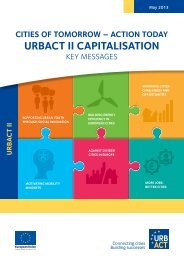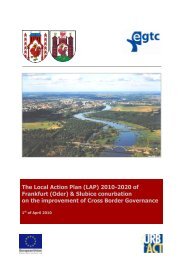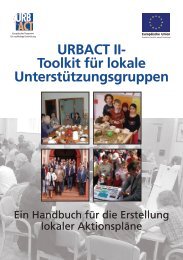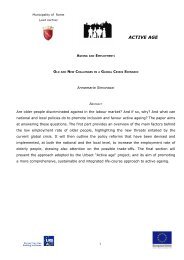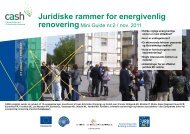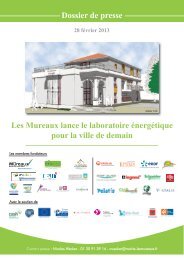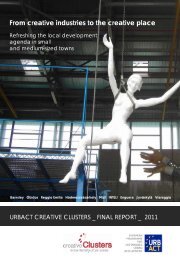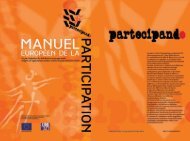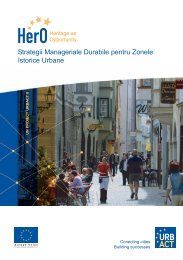ENTER.HUB_Baseline study PDF, 6 Mo - Urbact
ENTER.HUB_Baseline study PDF, 6 Mo - Urbact
ENTER.HUB_Baseline study PDF, 6 Mo - Urbact
Create successful ePaper yourself
Turn your PDF publications into a flip-book with our unique Google optimized e-Paper software.
EUROPEAN<br />
UNION<br />
European Regional<br />
Development Fund<br />
Redefinition of the modified now 9 Themes<br />
1 <strong>HUB</strong> AS A NODE/INTERFACE<br />
1a<br />
1b<br />
1c<br />
1d<br />
As interchange junctions, these hubs have to strengthen their capacity of connecting different rail<br />
networks in order to enable them to feed each other and to satisfy the demand of transport service of<br />
the whole territory.<br />
The arriving of the HSL and of other main railway lines favours some centres (those which dispose of a<br />
HS station) to the detriment of the others (“tunnel effect”).<br />
Nevertheless these railway lines, making possible connections at a wide scale, can contribute to a<br />
development and an expansion of the railway transport system at a local and regional level (included<br />
tram and tram-train systems). The “regionalisation” and “collectivisation” of HS lines/other main<br />
railways should consist in this “putting in network” of the two systems, the main railway system and<br />
the secondary but more widespread system (regional and local lines), in order to make accessible the<br />
two systems to as many users as possible.<br />
COORDINATOR PARTNER: REGGIO EMILIA<br />
The development of an intermodal hub implies to rethink the articulation with the rail (both the main<br />
and the local lines) and the road (both local, regional and national, e.g. freeways) infrastructure of the<br />
catchment area (and beyond). A good and sustainable accessibility must be secured, integrated in the<br />
global urban functioning, and the efficiency and permeability of these different systems, with a<br />
specific attention to traffic flow and parking control.<br />
The need of optimizing (instead of to extending) the road infrastructure in order to en able them to<br />
serve an intermodal hub needs a specific investigation.<br />
The hub will have to ensure an efficient connection between the train and the other modes (motorised<br />
and active modes) as well as compatibility and complementarity among those modes, with an on-going<br />
concern for minimizing traffic congestion and optimizing accessibility<br />
COORDINATOR PARTNERS: CREIL + REGGIO EMILIA<br />
Today, the issue of mobility implies to reconsider the functioning of all the systems of public<br />
transport. Trains, urban and intercity buses, bicycles, pedestrians, not forgetting shared systems and<br />
cars, all must be regarded in a comprehensive/global way, as a “chain of trips” in which everyone can<br />
easily switch from a mode to another (seamless travelling).<br />
Thus, the station will be considered at the scale of its catchment area: the development of a local and<br />
regional system of public transport will allow both to serve the catchment area and also the widening<br />
of the hub’s catchment area itself. Networking the hub with other junctions/centralities located in the<br />
whole territory will allow to strengthen the already existing centralities and to generate other ones,<br />
being easily accessible through the local transport system. In this way the whole territory and all users<br />
will benefit from the hub development.<br />
The special issues to be investigated are: 1. how to create a multimodal hub within or outside the city<br />
centre which is focused on public transportation; 2. how to create a node which integrates not only<br />
the public transportation system within the city but also integrates it with railway system and<br />
interregional bus transportation system; 3. how can a good public transport node, together with<br />
interchange and intermodality supply, encourage citizens to use public transport instead of cars, for<br />
local and national travel.<br />
COORDINATOR PARTNERS: LODZ + CREIL<br />
The new main railway lines are usually planned for allowing a mixed traffic (passengers and freight).<br />
This aspect can bring to particular urban and territorial assets (I.e. logistic platforms), though<br />
sometimes with conflicts if the hubs are located in urbanized areas (there is sometimes also the<br />
question of capacity, since the speeds of high-speed and goods trains are very differentiated). But<br />
many potentialities on passenger-freight traffic integration can be foun. Robust, attractive and fast<br />
public transport, combined with efficient freight transportation with high capacity, are key factors for<br />
sustainable development and growth, competitiveness, enlargement of regions and good living<br />
conditions for the next generations.<br />
COORDINATOR PARTNER: ÖREBRO<br />
<strong>ENTER</strong>.<strong>HUB</strong> <strong>Baseline</strong> <strong>study</strong> 2012.10.31<br />
78



